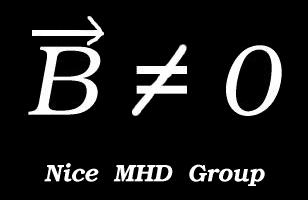
|
UK MHD Meeting 2004
Thursday 6th and Friday 7th May 2004
Nice - Cote D'Azur
Laboratory Cassiopée UMR6202 CNRS
Observatory of the Cote d'Azur
|
  |
Magnetic and
viscous torques at the core mantle boundary
Berangere Deleplace & Philippe
Cardin, LGIT Grenoble
Differential rotation between the liquid core and the solid mantle
generates a thin layer at the
top of the core where the lorentz and viscous forces may balance the
coriolis forces and play a
major role. We solve the induction and the momentum equation to compute
the velocity and the
magnetic field in boundary layer.
Different regimes are possible. On a hand, when the difference of
conductivity between the mantle and the core is
small, a pure magnetic case may take place where induced electrival
currents are produced in a skin layer and loop
into a conductive solid layer in the mantle. On an other hand , given
that the fluid in the outer
core is likely to be subject to high convection, we can assume an Ekman
layer based on eddy
viscosity of $10^{-1} m^{2}/s$, such a pure viscous case where an Ekman
layer generate a vicous skin at the base of the
mantle is possible as well. A visco-magnetic regime where both, viscous
and magnetic torques
work togheter to balance the change in angluar momentum and influence
the Earth's axis of rotation
is also investigated.
Using the result of the nutation theory (Mathews et al, 2002)
we show that in order to retrieve VLBI (Very Long Baseline
Interferometry) data,
the magnetic field at the C.M.B has to be smaller than the value find
by previous authors
with a similar inviscid analysis(Buffet et al, 2002).





